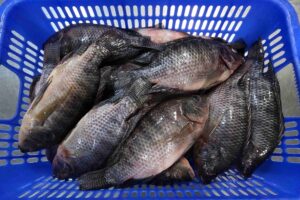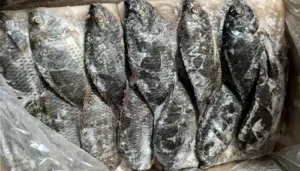Wrong information about tilapia makes customers unsure. This confusion can hurt your sales and stop your business from growing. We are here to give you the real facts.
Tilapia is a freshwater whitefish with a mild, slightly sweet taste. It is one of the most popular fish in the world. People like it because it is easy to farm, affordable, and simple to cook. This makes it a great core product for your business.
Many people have questions about this fish. Is it healthy? What does it eat? What does it taste like? These are important questions. As a long-time tilapia supplier, we have the answers. We want to clear up any confusion. We want you to feel good about the product you sell. Let’s look at the facts together.

What Does Tilapia Taste Like?
Your customers might worry that tilapia has a strong fishy taste. This concern can lead them to choose an alternative product, and you may lose a sale. We can help you explain it.
Tilapia has a very mild and gentle flavor. It is not fishy at all. Instead, it is slightly sweet. Its taste is so light that it easily picks up the flavors of sauces and spices. This makes it perfect for almost any recipe.
Diving Deeper into Tilapia’s Flavor
Its main strength is its mild taste. It does not overpower other ingredients in a dish. This makes it great for grilling, baking, frying, and even putting in curries.
When you cook it, the meat turns white and becomes flaky. But it is still firm enough. It will not fall apart on a grill or in an oven.
It’s important to know that how a fish is raised affects its taste. This is why we are so careful about where we get our fish. We only work with farms that use clean water and good feed. This ensures every fish has a clean, pleasant taste.

| Attribute | Description |
| Taste | Mild and a little sweet |
| Smell | Not strong, not fishy |
| Textur | Firm but flaky when you cook it |
| Good For | Almost any cooking method |
Is Tilapia a Healthy Fish to Eat?
Some say it is healthy, others say it is not. This can cause your customers concern and negatively impact your business. Cause your customers’ concern and negatively impact
Yes, tilapia is a very healthy fish. It is full of lean protein and low in calories and fat. It also has very low levels of mercury. This makes it a safe and healthy protein choice for almost everyone.
Diving Deeper into Tilapia’s Nutrition
According to health experts, even children and pregnant women can eat it safely. For our partners, tilapia is a key product for providing their communities with affordable, safe, and healthy food.
| Nutrient (per 100g) | What It Means |
|---|---|
| Protein | About 26 grams |
| Calories | About 128 kcal |
| Fat | Very low, around 3 grams |
| Mercury | Extremely low level |
Is Tilapia a Bottom Feeder?
A common myth says tilapia are dirty “bottom feeders.” This is a poor image that may deter people from eating the fish. It stops them from trying a great product.
No, tilapia are not bottom feeders. They mainly eat plants and algae near the water’s surface. On the professional farms we work with, they feed their animals exceptional grain-based food. This guarantees the fish are clean and taste good.
Diving Deeper into the Tilapia Diet
The “bottom-feeder” idea is a big mistake. In the wild, tilapia eat plants, not mud. On modern fish farms, their diet is even more controlled.
We only work with farms that adhere to strict guidelines for feed and water quality. This means the tilapia you get from us is a clean, safe, and high-quality product.
| Myth | The Real Fact |
|---|---|
| Tilapia are bottom feeders. | They eat plants near the top of the water. |
| They eat mud and waste. | They eat special grain food on farms. |
| They are a dirty fish. | Farm-raised tilapia is an immaculate and safe fish. |
How Can You Tell If Tilapia Has Gone Bad?
Food safety is the most important thing. No one wants to get sick from rotten fish. Just one bad experience can permanently damage a customer’s trust in your business.
You can tell if tilapia is bad by its smell, texture, and appearance. It will have a strong, sour, or ammonia-like smell. It will feel mushy or slimy, not firm. It will also look dull and gray. If it seems wrong, do not use it.
High-quality tilapia factories make frozen tilapia which is good.

Diving Deeper into Spotting Spoilage
Keeping fish safe is our primary job. We maintain a strict cold chain to ensure the safe delivery of our products. But it’s still smart to know the signs of rotten fish. Here is a simple guide.
Good Tilapia vs. Bad Tilapia (after thawing):
| Sign | Good Tilapia | Bad Tilapia |
|---|---|---|
| Smell | Smells fresh. | Smells very fishy, sour, or like ammonia. |
| Touch | The meat is firm. It bounces back if you press it. | The meat is soft and mushy. It stays dented. |
| Sight | The color is white or pinkish-white. | The color is gray, yellow, or dull. |
The most important rule for food safety is simple: “When in doubt, throw it out.” A strong partnership with a reliable supplier like us is your best protection. We guarantee that our tilapia is safe and of high quality.
Ready to Supply Your Market with Great Tilapia?
Let’s talk. We can help you find the best tilapia products for your customers. We provide the quality and reliability you need to grow. Please feel free to contact us for a quote.
FAQs
Q1: Is tilapia a real fish or a man-made fish?
A: Tilapia is a real, naturally occurring fish. It is farm-raised, not man-made or genetically engineered.
Q2: Why is tilapia considered an unhealthy “dirty” fish?
A: This reputation comes from reports of poor farming practices in unregulated farms. By choosing certified tilapia (ASC, BAP), you can ensure it was raised cleanly and safely.
Q3: Which is healthier, tilapia or salmon?
A: Salmon is healthier if your goal is to consume heart-healthy Omega-3s. Tilapia is healthier if you want a very lean, low-calorie protein source. Both have their place in a healthy diet.
Q5: Is tilapia from China safe to eat?
A: Yes. The best practice is to always look for the certification logo, regardless of origin.




